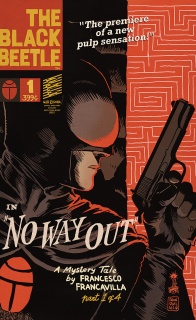I come into this review a little biased: Francesco Francavilla is one of my favorites creators in the current “wave” of comic professionals. Still, I firmly believe that the first issue of “Black Beetle – No Way Out” is a stellar example why.

Written and Illustrated by Francesco FrancavillaBlack Beetle’s investigation of two local mob bosses is interrupted when a mysterious explosion murders them and a pub full of gangsters–taking out most of Colt City’s organized crime in one fell swoop. Who could pull off such a coup, and what danger might that murderous bomber do to Colt City and Black Beetle?
In case anyone ever doubted (they didn’t), Francesco Francavilla has the pulp feel down to a science. Francavilla’s use of light and shadow — with an emphasis on the latter — evoke the style of the covers to old dime novels. Unlike many other artists on the shelves, who give their shadows a harsh, angular divide in order to make certain areas of their figures and objects “pop,” Francavilla’s are much smoother, and focus more on creating an atmosphere. While heavy shadows are frequently present, though, they never obscure the composition of his panels; no matter how dark a panel is, the defining, essential features of its content are always clearly visible. Francavilla’s color palette is also crucial to the tone. While many comics, superhero ones in particular, rely on bright, striking colors to dazzle the reader, Francavilla’s choices are always more reserved and muted, while no less bold. The deliberately washed out look mimics that contradictary quality of the old school pulps, how somehow the poor, easily faded paperstock of those covers make them stand out all the more in our mind.
The major difference, of course, is that Francavilla’s pages tell the story, rather than give the viewer a mere snapshot of what to expect inside. And boy, can he tell a story. Over the years, Francavilla has developed a style that is extravagant when it can be, utilitarian when necessary. Never does Francavilla bite off more than he can chew: if the motions taking place in the scene he’s drawing are going to be difficult to convey, then he’ll restrict himself to a basic grid of quadrelaterals, making sure that the action is effectively communicated rather than obscured by too creative layouts. Function always supercedes form, but that doesn’t mean Francavilla doesn’t pull out the big guns when he gets the chance. If the panel-to-panel motion is easily handled (which, when you’re as talented as Francavilla, is more often than not), or when the goal is more to evoke certain emotions rather than show anything in specific, the artist goes all out. As an example of the former, when the titular Beetle has a conversation with an imprisoned ne’er do well, Francavilla uses this opportunity to build an impressive frame for his panels; for the latter, the first action scene of the book begins with a wonderful page that aims to acheive a sense of excitement more than it does to show specifics, and succeeds tremendously. Some of the most talented Illustrators in the industry can often be their own worst enemies, complicating already difficult scenes to the point of confusion. Francavilla knows when to say when, and delivers page after page of pure quality, whether that page is ornately lain out and framed or — even more difficult — merely a “plain” page that reveals some of the best sequential storytelling around.
Just as he knows how to illustrate pulp heroics, though, Francavilla knows how to write them. This mini’s first issue gives newcomers a basic “get-it-got-it-go” before launching into action, making sure that enough of the first issue is dedicated to getting the reader hooked. Like proto-superheroes such as the Shadow or the Phantom, we don’t need a dossier on the Black Beetle’s beginnings if the story doesn’t concern his origins — we just need to know that he fights for justice in a world gone bad. The plot hook is a classic, though Francavilla makes the smart decision to introduce it early in the issue rather than as a last minute cliffhanger; the ending we get is far more satisfying and sure to bring readers back to the comic shop than the current comics trned of ending a first with a halfhearted “by the way, here’s what this story is about.” For the most part, this issue is sequence of action scenes, cutting from one moment of excitement to the next, just as it should be — aside from a page or two of brooding, this isn’t the place for deep introspection. The dialogue is crisp and sharp, without at all coming off as clunky or abrupt. Just as he has studied the look of the pulps and the comics they influenced, Francavilla has scritinized their text and structure, and applied that knowledge to crafting a great comic through and through.
Fans of Francesco Francavilla through his work on “Detective Comics” and “Zorro” — again, as a remind, you need to read his “Zorro” — have anxiously been awaiting for him to step back out of the world of company-owned characters, and “The Black Beetle” does not disappoint. A visual delight, and a genuinely entertaining read, the first chapter of “No Way Out” is just the thing for those with a love for all things pulp, or who just enjoy this talented artist’s work. And, hey, if you still aren’t familiar with him, there’s no better place to start than here!
Final Verdict: 8.5 – Buy it!



